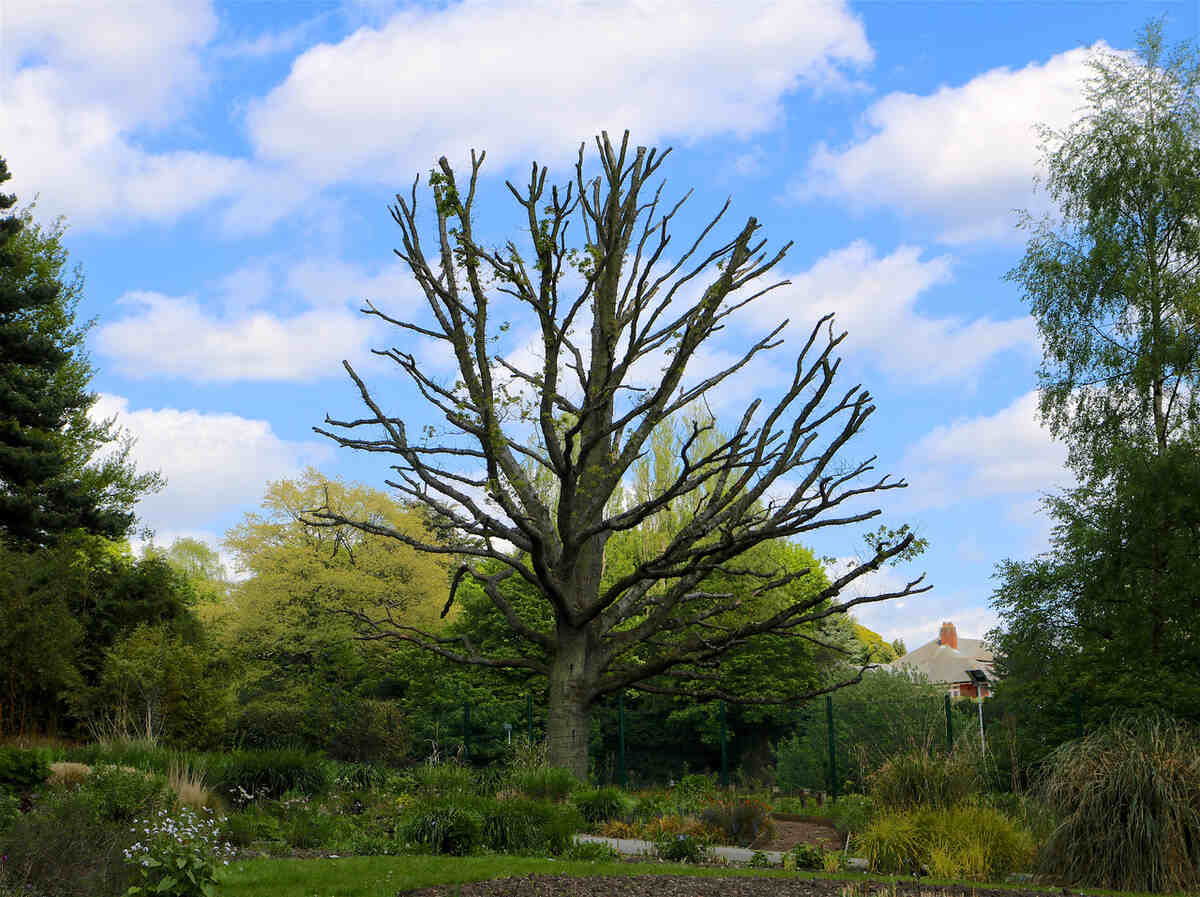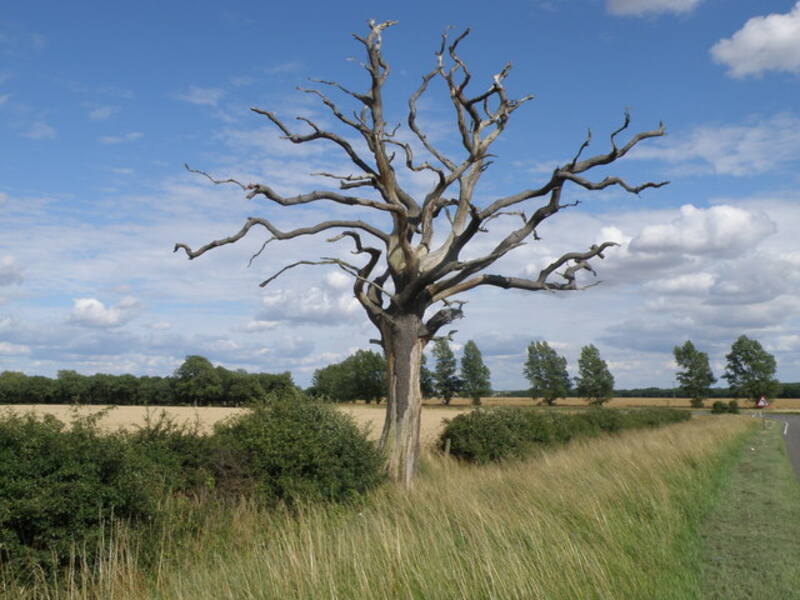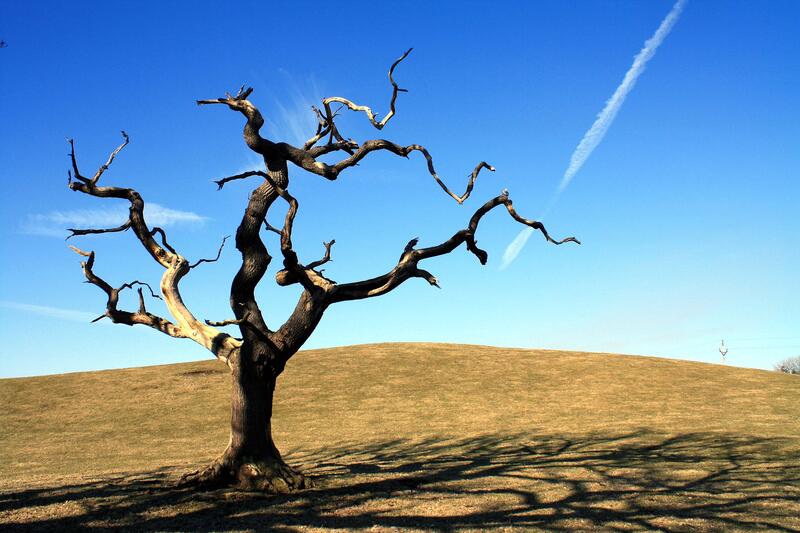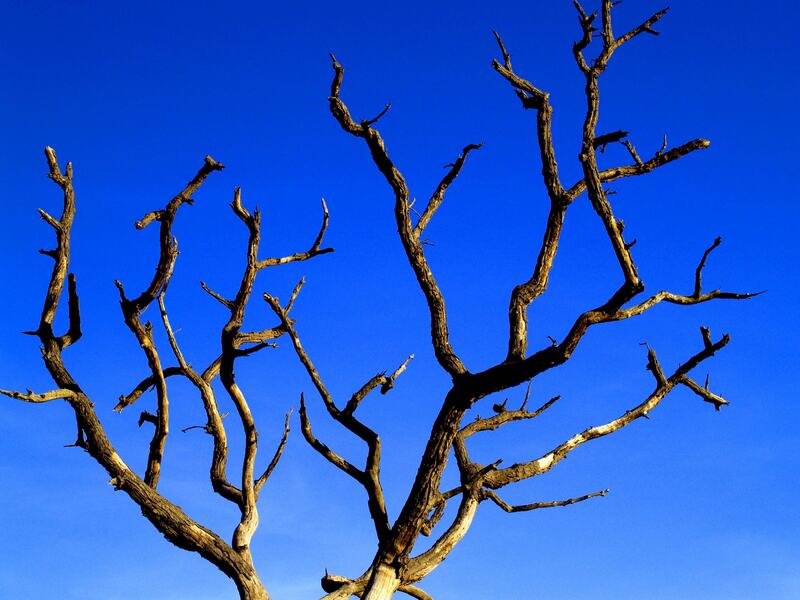
Zombie trees sound scary, but if you take the proper precautions, you won’t have to fear these living dead. So, what is a zombie tree? Zombie trees are trees that are slowly dying from the inside out due to damage from thunderstorms, hurricanes, ice storms, drought, or insects.
If you think you have a zombie tree, there may be hope. Some zombie trees can rebound with proper care, while for others, removal may be the safest option. We’ll explain how to identify a zombie tree and what steps you can take to try to bring these dying trees back to life.
Are Zombie Trees Alive?
Yes, like many of us before our morning coffee, zombie trees are alive on the outside and dead on the inside. The vascular system continues to operate, but the interior is beginning to decay. As a result, zombie trees can look like perfectly healthy trees, grow flowers, and produce foliage in the spring.
What Causes Zombie Trees?
“Trees grow, and as they age, they have something in the center called heartwood,” says Jason Grabosky, professor of urban forestry in the Department of Ecology, Evolution, and Natural Resources at Rutgers University. “Heartwood is the dead inner wood, and there’s sapwood, which is the living outermost portion of the tree.”

The tree’s heartwood is its main support, protected by the outer layers. When a tree is damaged from hurricanes, a hard freeze, or pests, the heartwood can develop fungus or otherwise begin to rot. The tree becomes hollow from the inside out, eventually dying completely.
A tree dying is natural. They don’t live forever, but with proper care, they can last a long time.
The leading causes of tree death are:
- Insect infestations
- Fungal disease
- Extreme weather
- Poor soil
How to Tell if a Tree is Dying
Not all sick trees look ill to the untrained eye, and different tree species will show various symptoms. A live tree with problems you must address is also a zombie tree. Give your trees a checkup every spring to avoid them becoming the undead.
Here are the signs and stressors you should look for:
- Canopy: The lack of leaves and the sight of bare branches may suggest malnutrition due to poor soil or internal damage.
- Leaves: Foliage with dead tips, discoloration, or losing leaves prematurely (on a mature tree), may indicate drought stress, physical trauma, or illness.
- Branches: Check for brittle or broken limbs, deadwood, decay, or fungus on the tree. “Dead branches that are all on one side of a tree can be a symptom of root or trunk damage on the affected side,” according to horticulturists at the University of Maryland Extension.
- Trunk: Cracks and/or deep splits through the bark in the trunk or limbs, bark falling off, or the tree leaning toward one side are all signs of decay. Damaged roots, intense wind, an unbalanced crown, or even not being planted correctly can all contribute to this.
- Roots: Cracks in the ground or heaving soil indicate root problems, including dead, fractured, or infected roots, which you may have to remove.
“Root decay cannot be reversed or corrected, and its presence causes a tree to be less physically stable,” according to the University of Colorado Extension. “If its root system is compromised, the tree will decline, or even worse, fall.”
- Insects: Infestations from termites, bark beetles, mites, aphids, ants, and other common tree pests can all cause damage to trees. You can save them if caught in time.
How to Save a Dying Tree

How do you treat a zombie tree? It is possible to raise your trees from the dead and make them healthy again. “I’ve seen trees in decline rebound from infestations,” Grabosky says. “A lot depends on the species of tree and how much damage has been done.”
First, identify the problem. Trees can endure any number of pests, diseases, or other damage, and, as stated above, the type of tree you have can help you figure out the problem.
- Species-specific: Different types of fruit trees will have different issues. A peach tree may suffer from peach leaf curl, while your cherry trees are prone to cherry leaf spot. They can both fall prey to powdery mildew or brown spot.
- Cross-contamination: Cedar trees can spread a fungus to apple trees called cedar-apple rust, which makes the fruit inedible and may kill both the cedar and the apple tree.
- Insect damage: If it is an insect infestation, like cankerworms, pine beetles, wood borer, or Japanese beetles, and you catch it early, you can transform a near-dying tree into a healthy one.
- Climate changes: For some problems, such as drought or hurricanes, you’ll want to call a certified arborist or licensed tree expert to evaluate the situation.
Trees require adequate light, air, nutrition, moisture, and growing space to thrive. To save a dying tree and turn it into a healthy one, try the following:
- Water: Check how much water you are giving your trees. Too much or too little can harm it and cause root rot. Feel how moist the soil is by digging it with your finger or a screwdriver. If it feels dry, it’s time to water; if it feels wet, wait a few days before watering.
- Prune: Because decaying branches can serve as entryways for insects and illnesses, appropriate pruning is necessary for healthy trees.
- Fertilize: A lack of proper nutrients could be the reason for your tree’s stress. Test your soil and add the appropriate amendments.
- Mulch: Mulching at the base of a tree will feed the soil, restrict fungus growth, regulate soil temperatures, improve drainage, and promote the tree’s long-term health. Keep the mulch at least 3-6 inches away from the trunk.
- Protection: Use integrated pest management (IPM) to protect your landscape from pests. IPM is a long-term pest, weed, and disease control approach that is environmentally friendly and safe for humans, pets, and wildlife.
Tree Removal
“Climbing up on ladders with power tools can be dangerous if you don’t know what you’re doing,” Grabosky says. “Hire a professional to remove your dying tree. And depending on where the tree is located, you might want to leave it where it is.”
Some dead trees placed away from houses and roads won’t cause any damage if they fall, and they provide homes to animals. “A biologically dead tree is just fine,” Grabosky says. “We need these habitats for a healthy ecosystem. Remember, just because it’s dead doesn’t mean it’s dangerous.”
What About Shrubs and Bushes?

Shrubs and bushes can also become the living dead. You can tell by looking at the dry, brown, and brittle leaves on the branches. You may be in luck if you notice any green foliage or flowers. Gently scrape away a bit of the outer layer. After scraping the bark, your shrub is alive if you see a bit of green underneath.
It’s important to note the time of the year, too. Some bushes and shrubs can become dormant in the winter and summer months. If you want a green landscape all year long, consider planting evergreen shrubs.
FAQ: Zombie Trees
No. Both are haunting, but for different reasons. Zombie trees have perished due to a pest, illness, or other injuries, which can happen anywhere trees grow. However, it is common in central Florida due to hurricanes and in Texas during extreme droughts or freezes.
Ghost forests are often widespread along coastlines, usually by a combination of sea level rise, eroding soil, and altered water flow caused by road construction.
Never try to fix a broken tree with ropes, cabling, wires, fasteners, or other similar products. The odds are that the effort will not make the tree any safer. This is a situation that requires professional help. Call a professional arborist to secure the tree properly.
Diseases are spread amongst trees in a few ways:
● Tools not thoroughly disinfected after being used on an unhealthy tree can spread disease.
● Infectious diseases that affect trees’ leaves are spread by wind and water drops that fall from sick trees to healthy trees.
When you take into account the cost of planting new trees, it’s worth the investment to make sure they stay healthy. Consider hiring an arborist to come for regular tree inspections before winter or hurricane season (depending on where you live) or before you purchase a new property to ensure disease-free trees for many years to come.
Yes, in an urban environment zombie trees are dangerous. A zombie tree that appears to be rooted in the ground can topple over and crash on top of your car, garage, house, or even people. The likelihood of that happening is small — especially if you pay attention and address problems early.
In a rural environment or forest, zombie trees can be beneficial. Dead or dying trees (also called “snags”) provide needed habitat and nesting sites for birds and other wildlife.
When to Call a Pro
While zombie trees and ghost forests sound perfect for a real-life haunted house, as a homeowner you’ll probably want to deal with the spooky intruders before they become a nightmare. When a tree-care professional inspects your trees, they can determine the source of the problem and, if possible, guide you in restoring your tree.
Main Image Credit: Shutterstock
